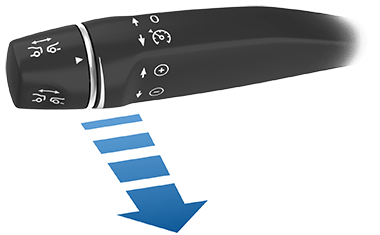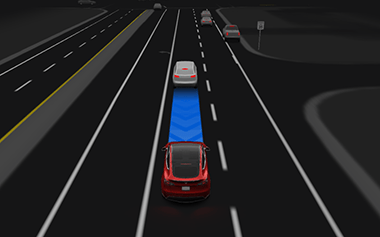Full Self-Driving (Supervised)
When Full Self-Driving (Supervised) is engaged, Model S attempts to drive to your destination by following curves in the road, stopping at and negotiating intersections, making left and right turns, navigating roundabouts, and entering/exiting highways.
Unlike Traffic-Aware Cruise Control, Autosteer , and Navigate on Autopilot , which are intended for use on multi-lane roadways with clear lane markings, Full Self-Driving (Supervised) is meant to work in a variety of driving scenarios. You can use Full Self-Driving (Supervised) on any type of roadway, including residential and city streets.
Like other Autopilot features, Full Self-Driving (Supervised) requires a fully attentive driver and will display a series of escalating warnings requiring driver response. You must keep your hands on the steering wheel while Full Self-Driving (Supervised) is engaged.
Before Using Full Self-Driving (Supervised)
- Enable Full Self-Driving (Supervised) . Touch and then, after carefully reading and understanding the popup window, touch Yes.
- (Optional) Customize
Full
Self-Driving (Supervised)
settings.
- Full Self-Driving (Supervised) Profile: If desired, change the default setting of Standard to Chill or Hurry. Chill provides a more relaxed driving style with minimal lane changes and Hurry drives with more urgency. While Full Self-Driving (Supervised) is engaged and Model S is traveling at highway speeds, tilting the right scroll button to the right or left changes the Full Self-Driving (Supervised) profile.
- Max Speed Offset:
Set the percentage offset over the currently detected speed limit that
Full
Self-Driving (Supervised)
can drive if it
is necessary to drive faster than the speed limit to match the flow of
traffic.WarningYou are responsible for the speed of the vehicle at all times, whether Autopilot is engaged or not.
- Use HOV Lanes: Choose whether Full Self-Driving (Supervised) uses High Occupancy Vehicle (HOV) lanes on your route.
NoteWhen Full Self-Driving (Supervised) is enabled, the setting for Autopilot Activation is set to Single Pull and Traffic-Aware Cruise Control and Autosteer are unavailable. - Ensure that the cameras on Model S are unobstructed and calibrated (see Cameras). Full Self-Driving (Supervised) depends on the ability of the cameras to detect traffic lights, stop signs, and road markings.
- Ensure that the latest version of maps has been downloaded to Model S (see Map Updates). Although Full Self-Driving (Supervised) primarily uses visual data received from the vehicle's cameras, greater accuracy is achieved when using the most recent map data.
To Use Full Self-Driving (Supervised)

If you do not choose a destination, Model S chooses the most probable driving path or suggests a destination based on your driving.

While Using Full Self-Driving (Supervised)
Full Self-Driving (Supervised) changes lanes, makes left and right turns, follows on- and off-ramps, and takes forks in the road as necessary to reach the destination.
Like Autosteer and Traffic-Aware Cruise Control, Full Self-Driving (Supervised) maintains your speed and following distance from the vehicle ahead of Model S, if there is one. Full Self-Driving (Supervised) also slows down and stops at traffic lights and stop signs as necessary, and reacts to pedestrians, cyclists, and other vehicles on the road.
For example, if you are driving on a residential street and another vehicle backs out of a driveway ahead of Model S, Full Self-Driving (Supervised) slows down or stops as appropriate. If the other vehicle stops backing out while partially blocking the driving lane, Full Self-Driving (Supervised) slows down and maneuvers around the other vehicle if the width of the lane allows it.
When the traffic in front of you is slowing down, Full Self-Driving (Supervised) shows blue arrows in the driving lane and slows down to maintain an appropriate following distance from the vehicle ahead of you. When you are driving on the highway, Full Self-Driving (Supervised) displays a message on the instrument cluster to inform you when an action (such as a lane change) is being taken.
Changing the Max Speed
The instrument cluster displays the max speed in blue. When Full Self-Driving (Supervised) is engaged, Autopilot sets the max speed based on the currently detected speed limit, the Full Self-Driving (Supervised) profile, and other factors (such as the speed of surrounding traffic).
Roll the right scroll wheel up to increase, or down to decrease, the max speed.
The max speed limits how fast Model S drives while Full Self-Driving (Supervised) is active, but does not determine how quickly Full Self-Driving (Supervised) drives your vehicle. To have Full Self-Driving (Supervised) drive Model S with more urgency, change the Full Self-Driving (Supervised) profile by pressing the right scroll wheel to the left or right. You can also press the accelerator pedal to manually increase the speed.
Changing Lanes
To tell Full Self-Driving (Supervised) to change lanes while on a multi-lane roadway, engage the right or left turn signal. On city or residential streets, engaging the right or left turn signal tells Full Self-Driving (Supervised) to make a right or left turn, respectively.
Unlike Navigate on Autopilot , Full Self-Driving (Supervised) does not require confirmation before a lane change. To cancel a lane change or turn, cancel the turn signal or intervene with the steering wheel or other vehicle controls.
Arriving at Your Destination
Once you reach your destination, Full Self-Driving (Supervised) stops Model S and displays a message indicating that navigation is complete.
Canceling Full Self-Driving (Supervised)
To disengage Full Self-Driving (Supervised) , do any of the following:
- Press the brake pedal.
- Push the Autopilot stalk away from you once.
- Take over and steer manually.
In addition, Full Self-Driving (Supervised) will disengage if any of the following occurs:
- You shift out of Drive.
- A door or trunk is opened.
- There is an Automatic Emergency Braking event (see Collision Avoidance Assist).
- The driver's seatbelt is released, and/or the driver gets out of their seat.
- You do not respond to repeated reminders to keep your hands on the wheel and subsequent messages on the instrument cluster.
- Full Self-Driving (Supervised) becomes unavailable. This can happen for a number of reasons (for example, if a camera becomes obscured). If Full Self-Driving (Supervised) disengages, an alert will appear on the instrument cluster to notify you and a chime will sound. If this happens, take control of steering immediately.
When driver intervention is required, it is best to safely disengage as soon as possible. It is recommended to practice disengaging from Full Self-Driving (Supervised) in safe environment without other road users so you may become familiar with the process.
Driver Attentiveness
Autopilot features require driver attentiveness. Your hands must be on the steering wheel at all times while Autopilot is engaged, and you must monitor your surroundings, the road, and other road users.
Autopilot periodically displays a message reminding the driver to apply slight force to the steering wheel:
Autopilot detects your hands by recognizing slight resistance as the steering wheel turns, or from you manually turning the steering wheel very lightly (without enough force to take over steering). Autopilot also qualifies your hands as being detected if you engage a turn signal use the Autopilot stalk, or use a button or scroll wheel on the steering wheel. If Model S does not detect slight turning force on the steering wheel, the instrument cluster flashes and eventually chimes repeatedly. Do not use handheld devices while Autopilot is engaged.
If you repeatedly ignore prompts to apply slight force to the steering wheel or to pay attention, Autopilot disables for the rest of the drive and displays the following message requesting you to drive manually. If you don't resume manual steering, Autopilot sounds a continuous chime, turns on the warning flashers, and slows the vehicle to a complete stop.
Autopilot Suspension
Use of Autopilot features will be suspended if improper usage is detected.
Use of Autosteer and Full Self-Driving (Supervised) is suspended for a week when you or another driver of your vehicle receives three Autopilot "strikeouts." A strikeout is when the Autopilot system disengages for the remainder of a trip after the driver receives several audio and visual warnings for inattentiveness.
You can see how many strikeouts are remaining before Autopilot access is suspended by touching .
A strikeout is forgiven after 7 days, as long as you don't receive another strikeout in that time.
There may be occasions where driver intervention is required and you must take over immediately to maintain safe driving. Driver-initiated disengagements do not count as improper usage and are expected from the driver.




